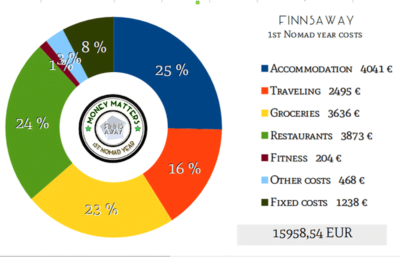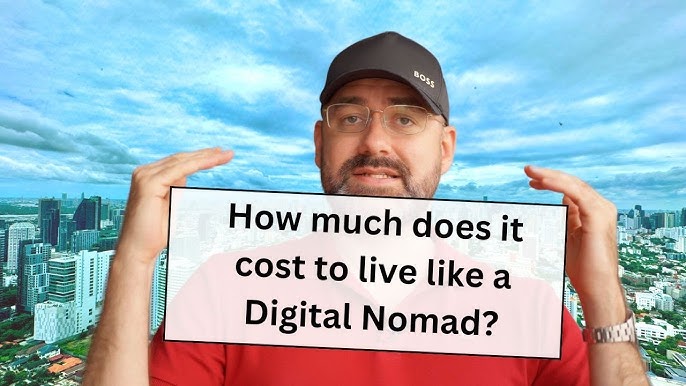Being a digital nomad is a dream for many. But what does it cost?
The answer varies widely. Factors like location, lifestyle, and work type affect expenses. Digital nomads embrace a life of freedom and adventure. They work remotely while exploring the world. Costs can be tricky to estimate. Some live in budget-friendly countries, while others choose pricier destinations.
Daily expenses include accommodation, food, and travel. Technology is a major part of their lives. They need reliable internet and gear. Health insurance and taxes also add to costs. Each digital nomad’s journey is unique. The key is planning and flexibility. Understanding expenses helps in making informed decisions. This lifestyle offers endless possibilities. But knowing the costs is crucial for success.

Credit: internationalbaate.com
Initial Setup Costs
The dream of becoming a digital nomad is enticing. But understanding the initial setup costs is crucial. You’ll need to budget for essential gear and travel documentation before you even set foot on the plane.
Essential Gear
Investing in reliable gear is non-negotiable. Your laptop is your lifeline. A high-performance laptop can cost anywhere between $1,000 and $2,500. Choose one that suits your work needs and is durable.
Don’t forget about accessories. A good quality headset, portable hard drive, and a universal adapter are must-haves. Budget around $200-$300 for these.
Stable internet is crucial. Consider a portable Wi-Fi hotspot or a local SIM card. These can range from $50 to $150, depending on the country.
Do you need a comfortable working space? An ergonomic laptop stand and a travel mouse can make a huge difference. These items are relatively inexpensive, usually under $100 combined.
Travel Documentation
Getting your travel documents in order is another significant upfront cost. A passport is the first step. If you don’t already have one, expect to pay around $100-$150.
Visas can add up quickly. Some countries charge as little as $20, while others may require a few hundred dollars. Research visa requirements for your destinations to avoid surprises.
Consider travel insurance. It’s an essential safety net. Policies vary, but a comprehensive plan might cost around $300-$500 for six months.
Are you planning to drive abroad? An International Driving Permit (IDP) might be necessary. This document typically costs about $20, plus any additional application fees.
By planning for these initial setup costs, you can embark on your digital nomad journey with confidence. What other expenses have you found crucial in your preparation?
Accommodation Expenses
Accommodation expenses can vary greatly for digital nomads. Your choice of living arrangements plays a crucial role in your budget. Let’s explore two popular options: short-term rentals and co-living spaces.
Short-term Rentals
Short-term rentals offer flexibility and variety. Websites like Airbnb and Booking.com have many options. You can find apartments, houses, or rooms for rent. Prices can range from $20 to $100 per night, depending on location and amenities. In cities with a high cost of living, expect to pay more. Smaller towns and rural areas often have cheaper options. This choice allows you to experience new places frequently.
Co-living Spaces
Co-living spaces are designed for people who want a community. These spaces usually offer shared living areas and private rooms. Co-living often includes utilities and internet in the price. Monthly costs can range from $300 to $1,500. The price depends on the city and the amenities provided. Many digital nomads prefer co-living for the social aspect. You can meet like-minded individuals and share experiences. This option also provides a stable home base for longer stays.
Transportation Costs
Transportation costs are a significant part of a digital nomad’s budget. Moving from place to place can add up quickly. But, with careful planning, you can manage these expenses effectively.
Flights
Flights are often the largest transportation expense for digital nomads. Finding affordable options requires research and flexibility. Use flight comparison websites to find the best deals. Consider booking tickets in advance to save money. Also, be flexible with travel dates to find cheaper flights.
Joining airline loyalty programs can also reduce costs. Frequent flyer miles can add up and lead to free or discounted flights. Sometimes, budget airlines offer lower fares. But, watch out for extra fees. Always read the fine print before booking.
Local Transit
Local transit varies by location. In some cities, public transportation is cheap and reliable. Buses, trains, and trams can be a cost-effective way to get around. Research local transit options before arriving. Many cities offer transit passes that can save money.
In other places, taxis or rideshare services might be necessary. Apps like Uber and Lyft are popular. They often provide a convenient and affordable way to travel. But, these services can be costly for long distances. Consider walking or cycling for short trips. Renting a bike can be a fun and cheap option.
Always budget for transportation costs. This helps avoid surprises and keeps expenses under control. Planning and flexibility are key to managing transportation costs as a digital nomad.
Tech And Connectivity
Being a digital nomad involves more than just traveling. Your tech and connectivity play a crucial role in your lifestyle. Staying connected means reliable internet and maintaining your gadgets. Let’s dive into the details.
Internet Plans
Internet access is vital for digital nomads. Different countries offer various plans. Research local providers in your destination. Choose a plan based on speed and reliability. Unlimited data plans are ideal for heavy users. Mobile hotspots are great for remote areas. Always check for hidden fees.
Some nomads use SIM cards for local internet. Buy a local SIM card for cheaper data rates. Compare prices from multiple providers. Ensure your device is compatible with local networks. Consider a global SIM card for multiple countries. This saves time and money.
WiFi availability varies in different locations. Cafes, co-working spaces, and libraries often provide free WiFi. Use apps to find WiFi hotspots. Always have a backup internet plan. This ensures you stay connected during emergencies.
Tech Maintenance
Keeping your gadgets in good condition is essential. Regular maintenance prevents unexpected breakdowns. Clean your devices regularly. Dust and dirt can cause overheating. Use protective cases to avoid physical damage. Backup your data frequently. This prevents loss in case of a malfunction.
Tech repairs can be costly. Learn basic troubleshooting skills. This saves money on minor issues. Research repair shops in your destination. Some countries offer cheaper repair services. Keep your software updated. Updates often fix bugs and improve performance.
Invest in quality tech gear. Reliable gadgets last longer and need fewer repairs. Carry essential accessories like chargers and adapters. These are crucial for uninterrupted work. Protect your devices from theft. Use tracking apps and secure storage.
Daily Living Expenses
Being a digital nomad involves balancing daily living expenses across different locations. Costs vary by country and lifestyle choices. Accommodation, food, and travel are the main expenses. Budgeting carefully can help manage these costs effectively.
Daily living expenses are a crucial part of being a digital nomad. They can vary widely depending on location. Some cities may have higher costs. Others may offer more affordable options. Understanding these expenses helps in planning your budget. Let’s explore the daily living costs that digital nomads often encounter.Food And Dining
Eating out can be a delight for digital nomads. Tasting local cuisine is part of the adventure. Prices differ from city to city. Street food is often the cheapest choice. In Bangkok, a meal might cost $2. In Paris, expect to pay $15 or more. Cooking at home can save money. Buying groceries and preparing meals is cost-effective. Local markets often have fresh produce at lower prices. Shopping wisely reduces food expenses significantly.Health And Fitness
Staying healthy is important for digital nomads. Gym memberships vary by location. In Bali, gyms might charge $30 monthly. In New York, it’s common to pay over $100. Outdoor activities are often free. Running, hiking, or cycling can keep you fit. Health insurance is a must-have. Costs depend on coverage and provider. Some nomads opt for travel insurance. Others choose international health plans. Regular check-ups and vaccinations are recommended. Prioritizing health ensures a smooth nomadic journey.
Credit: www.finnsaway.com
Work-related Costs
Being a digital nomad sounds exciting. Yet, it comes with costs. Work-related expenses are a big part of this lifestyle. These costs ensure you stay productive and connected. The digital world demands certain tools and spaces. Let’s break down these expenses.
Coworking Spaces
Coworking spaces are essential for many digital nomads. They offer reliable internet and a professional environment. Costs vary by location. In Southeast Asia, you might pay $50 to $200 monthly. In Europe, prices could rise to $200 to $400. These spaces often provide networking opportunities too. Some offer free coffee and meeting rooms. Consider your budget and needs. A coworking space can boost your productivity.
Software Subscriptions
Software tools are crucial for remote work. Most digital nomads rely on various subscriptions. Cloud storage, design tools, and communication apps are common. Costs can range from $10 to $100 monthly. Many platforms offer discounts for annual plans. Choose software that fits your work style. Free trials help you decide before committing. Review your subscriptions regularly. Ensure you use each tool effectively.
Insurance And Safety
Being a digital nomad is an exciting journey, but safety is important. Insurance is a key part of staying safe on the road. It helps protect against unexpected costs and emergencies. Let’s dive into two main types of insurance every digital nomad should consider.
Health Insurance
Health insurance is crucial for any digital nomad. Medical emergencies can happen anywhere. Having health insurance ensures you get the care you need. Many companies offer international health plans. These plans cover treatments in multiple countries. Prices vary based on your age, health, and coverage needs. On average, expect to pay between $40 and $150 per month. It’s a small price for peace of mind.
Travel Insurance
Travel insurance covers more than just medical emergencies. It also includes trip cancellations, lost luggage, and travel delays. This insurance helps save money and stress during your travels. Costs for travel insurance depend on your trip length and destinations. Typically, you might spend around 4% to 10% of your trip’s cost. For example, a $1,000 trip might have insurance costs of $40 to $100. This ensures you are covered for unexpected events on your journey.

Credit: www.arthurguiot.com
Miscellaneous Costs
Becoming a digital nomad involves various costs. While travel, accommodation, and meals are the major expenses, miscellaneous costs can add up quickly. Understanding these expenses can help budget effectively and avoid surprises.
Leisure Activities
Exploring new places often includes leisure activities. These can be anything from museum visits to local tours. Costs vary depending on the location. A city tour in Paris might be pricier than a beach day in Thailand. Participating in local events also adds to these costs. Attending a festival or concert can be a memorable experience but comes at a price. Budgeting for leisure ensures you enjoy your travels without financial stress.
Unexpected Expenses
Unexpected expenses can catch any traveler off guard. Medical emergencies are the most common. Even with insurance, there can be out-of-pocket costs. Lost or stolen belongings can also lead to unplanned spending. Replacing a laptop or phone can be expensive. Having a contingency fund helps manage these surprises. It’s wise to set aside a portion of your budget for emergencies. This ensures you stay on track even when faced with unexpected costs.
Frequently Asked Questions
Is It Expensive To Be A Digital Nomad?
Being a digital nomad can vary in cost. Expenses depend on location, lifestyle, and work arrangements. Affordable destinations and flexible budgets can reduce costs significantly. Many nomads find ways to live inexpensively, balancing travel with work. Careful planning and budgeting can make it affordable.
How Much Do You Need To Make To Be A Digital Nomad?
To be a digital nomad, you need to earn at least $2,000-$3,000 per month. This ensures comfortable living and travel.
What Is The Cheapest Country To Live As A Digital Nomad?
Vietnam is the cheapest country for digital nomads. Affordable living costs, delicious food, and vibrant culture make it a popular choice.
Do Digital Nomads Pay Us Income Tax?
Yes, digital nomads pay US income tax. US citizens and residents must report worldwide income, regardless of location. They may qualify for exclusions or credits to reduce tax liability.
Conclusion
Living as a digital nomad can be affordable with careful planning. Costs vary based on location and lifestyle. Researching destinations can help you budget better. Prioritize expenses like accommodation, food, and internet. Travel slowly to save on transportation. Utilize coworking spaces for productivity.
Embrace local experiences to enrich your journey. Remember, flexibility is key to managing costs. Enjoy the freedom and adventure that come with the digital nomad lifestyle. With the right approach, you can thrive anywhere in the world.






